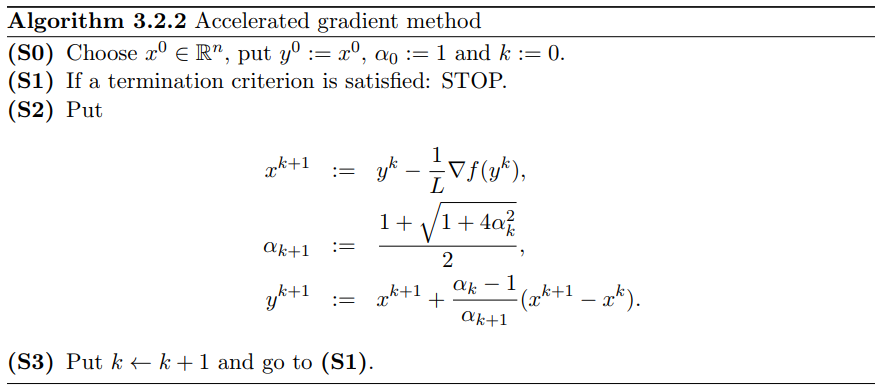Fast Gradient method with Armijo Rule¶
[17]:
import numpy as np
from IPython.display import display, Image, HTML
display(HTML("""
<style>
.output {
display: flex;
align-items: center;
text-align: center;
}
</style>
"""))
Quadratic Function¶
This function is a polynomial of degree 2.
The Quadratic function \(r: \mathbb{R}^n \rightarrow \mathbb{R}\) is given by:
\[f(x) = \frac{1}{2} x^T Q x + b^T x + c\]
[19]:
from src.function import Function
class Quadratic(Function):
def eval(self, Q, c, x, gamma):
return 0.5 * x.T.dot(Q).dot(x) + c + gamma
def gradient(self, Q, c, x):
return Q.dot(x) + c
def hessian(self):
pass
Example¶
The parameters will be the following:
\[\varepsilon := 10^{-5}, \delta = 0.01\]Start point will be the following:
\[x^0 := (1, 2, 3, 4)\]The Q matrix will be the following:
\[\begin{split}\begin{bmatrix}1 & 0 & 0 & 0 \\ 0 & 1 & 0 & 0 \\ 0 & 0 & 1 & 0 \\ 0 & 0 & 0 & \delta \end{bmatrix}\end{split}\]
[20]:
from src.optimizers.fast_gradient_method import FastGradientMethod
objective = Quadratic()
starting_point = np.array([1, 2, 3, 4])
delta = 0.01
epsilon = 0.00001
estimates = list()
iterations = list()
optimizer = FastGradientMethod()
x = optimizer.optimize(starting_point,
objective,
epsilon,
delta)
print(f'Optimal Point: {x}')
print(f'Iterations: {optimizer.iterations}')
Optimal Point: [ -1. -1. -1. -100.00082264]
Iterations: 711
